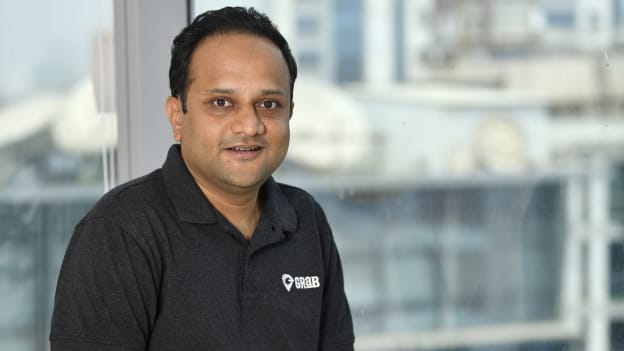HR is the glue that binds people and propels growth at Grab: Nishant Vora

The logistics tech space is booming and creating new job opportunities for the workforce across different segments. But managing such a large fleet of gig workers and rapidly growing business can be tough for the founding teams. How can a fast-growing organisation like Grab manage a workforce of over 6,000 GRABf as well as take care of over 1 lakh frontline riders of GRAB.
In an interview with Nishant Vora, Co-founder and Director, Heads Operations, HR and Strategy, GRAB.in, we explore what it takes to manage and scale a team in a fast-growing business.
Today, convenience is a critical factor for people to select and order from a brand. “We started with food delivery when no smartphones or technology existed, we had a website where a customer could place an order and get deliveries”, shares Nishant Vora, Co-founder and Director, Heads Operations, HR and Strategy.
The logistics landscape
In the past ten years, the emergence of smartphones, GPS, routing etc. has helped the logistics industry evolve. As brands realized that the fixed cost of last-mile could be converted into variable cost, sustaining became possible for players who were merging demands from different verticals.
So, starting with food, Grab took on all possible deliveries, from pharma to banking to even passport-visa - everything one umbrella. “Each business had its highs and lows and with all businesses together we could create an environment with a good offering to the rider or the delivery person so that he could earn money as and when people ordered”, shares Nishant. This was the stepping stone and ideology with which Grab started.
Being first movers, there was not enough capital to buy 10000 bikes, so Grab became the first to start gig-model trend in logistics or the last-mile where the delivery person comes with his or her own bike, be it anywhere in India.
“We have empowered this transition and changed the notion that a delivery rider is a dead job and that there is no earnings potential in it”, says Nishant. In fact, the transition is such that today we see engineers and part-time professors doing deliveries, due to the margins earned.
“It offers great work-life balance, part-time options, the opportunity to work a second job and work in one’s area. Now it is a norm”, quips Nishant. The future idea is to create a denser network to avail more cost advantages for both the company and the rider, and this begins with a people outlook.
The HR view
There lies great challenges in retaining talent.
“Startups have gained a bad name, because of hire-fire policies, funding crunch issues, companies constantly pivoting etc.”, says Nishant.
He believes that how a company works is one of the key aspects to retain talent, and walks the talk to curate the right culture. Here are some initiatives that are shaping a better culture at Grab:
New joiner Induction: Virtual connect was enabled through a process-driven format. A 7-day event allowed senior leaders to spend time with the new joiners, making new hires feel connected and empowered to do meaningful work.
Culture of stability: Grab has not laid off a single person till date when faced with cash crunch, and assures that it will never do so. The leader believes that in such situation, there are lot of other options to consider. This has helped Grab gain credibility as a stable employer.
Flexibility and entrepreneur mindset: Finance moving into Operations, operations person handling P&L- such flexible opportunities attract people and help create a great brand image through word-of-mouth. Also, because logistics is a 24*7 operating job, the company had people working from remote locations and taking care of work on calls etc. even pre-Covid, to avoid burnout. “Post-Covid too, we do not have pressure of people coming to office. If a department wants people coming in five days a week, I question them”, shares Nishant.
Profitability-centric hiring philosophy: Grab maintains a reasonable cap on the maximum appreciation given to new hires, usually pegged at a maximum of 20%. Appraisals also happen moderately so that the company remains profitable and employees jobs remain safe. “We do not do 2X, 3X hikes, and this has helped us create an image”, mentions Nishant.
Learning and Development: With an app-based L&D platform, Grab focuses on a Q&A-based learning ecosystem. For example, if a rider has rejected an order which could have been attempted, the person is redirected to take some training programs to maintain the quality of order.
Compensation opportunities: Good earning opportunities and options for riders helps quell attrition, keeping it at a 9-10% versus industry norms of 15%. Also, Grab provides riders a platform where they can select what they want to get into, by evaluating the pros and cons. For example, in ecommerce riders can finish many deliveries with one bag, but the bag can get heavier and lead to health stress. Food deliveries do not allow for many orders, but can operate in a very small radius and get tips. Grab’s pay-per-packet model is linked with a wallet which gets credited every time a delivery is made, this helps build ownership of the rider as a micro-business.
Career growth journeys: Riders at Grab have become central level SPOCs, have reached AM or supervisor levels, and benefited from the quarterly R&R. “We give aspiration to people that ‘this is not where I end’. This is critical to get them to stay”, says Nishant.
Technology has helped deliver a consistent experience to both employees and customers, by being centred on the key touchpoint- the delivery person, even as the company has scaled up.
People management at Grab was not always so evolved. “We did not have many funds initially, and made the mistake of getting specialised HR later into the company”, believes Nishant.
But jumping up the ladder fast helped.
The future expectation from HR is to get consistency in the employee experience, fostering attachment with the employer and belongingness with the organisation, especially in today’s virtual setting.
To make people a part of the family, HR needs to intervene and make a process to ensure interactions through activities.
“HR forced me to explain to our employees the Whys of some of our business decisions”, shares Nishant. Such connection is especially required with the Gen Z talent pools; they have a great hunger to grow and perform and love individual ownership.
“Our average age is 30 years, so if you can manage and retain these 26-something-year-olds well, they will take the company to the next level”, believes Nishant. Identifying such people with the right aptitude and intellect who have the potential for the next leadership, is a win-win not just for Grab, but for every company.








